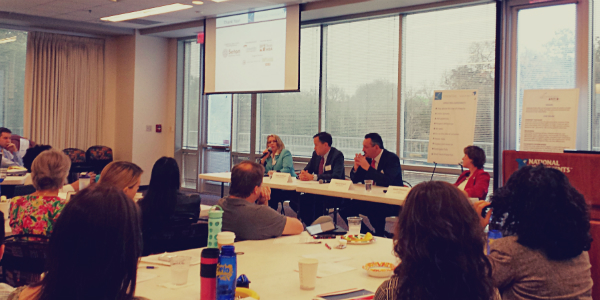
Guest post from Essential Class of 2014 participant Matt Stillwell, reflecting on the February class day on education and workforce development. Matt is an independent insurance agent in Austin.
—–
 Susan Dawson (Essential 1992)—an engineer by trade and E3 Alliance President by passion—led our morning sessions. She started with a bit of good news: by almost any measure, education in America has improved over time. It’s better than it used to be. But then she revealed the problem: other countries are getting better too, and faster. There is a competitive gap between the U.S. and other countries, and it’s growing.
Susan Dawson (Essential 1992)—an engineer by trade and E3 Alliance President by passion—led our morning sessions. She started with a bit of good news: by almost any measure, education in America has improved over time. It’s better than it used to be. But then she revealed the problem: other countries are getting better too, and faster. There is a competitive gap between the U.S. and other countries, and it’s growing.
The E3 Alliance was formed to address this problem and close the gap. They work to coordinate regionally with school districts, higher education, business interests and other stakeholders to be a catalyst for positive system change in education.
Twenty minutes into her presentation, Ms. Dawson mentioned poverty for the first time, which arguably is the most influential variable in predicting future student success. When dealing with Texas public schools, poverty is equated to students enrolled in the free and reduced lunch program, and enrollment in that program is up and expected to continue rising. Access to early childhood education is lacking as well (only about half of students in Central Texas are prepared to enter Kindergarten), even though the research clearly shows this period is critical in laying a solid foundation for academic excellence.
Education is a complex issue. A student’s attendance rate affects funding to the local campus and also directly correlates to the dropout rate, and the reason for an absence varies. Access to healthcare can directly impact attendance, as kids who get sick miss school. Transportation, economic factors (like a student who must choose work over school), teenage pregnancy and other issues directly impact the educational system and the results produced. Unpacking the problem and understanding how various factors combine to affect each other is essential in developing comprehensive solutions to the challenges in our educational system.
Texas makes education even more complex by fostering local independent districts, which has resulted in producing very little incentive for those districts to cooperate with each other, and often the districts are in direct competition with each other for educational programs and dollars. Texas has over 1,200 Independent School Districts. There is little appetite to change this system.
Our morning panel was focused on system change and the success of all students, and included Daniel Girard, principal at Akins HS, David Kauffman, principal of Perez ES, and Linda Smarzik, Dean of Computer Sciences and Advanced Technology at ACC, with Ms. Dawson acting as moderator. Standardized testing was discussed in depth at this point for the first time. The culture of testing that has developed relatively recently has created a slew of unintended consequences, such as a narrowing of the curriculum that teachers are expected to teach and an increase in the stress and pressure inflicted on teachers and students.
Our students are a captive audience; they have to be there. But only their bodies are captive, their brains aren’t. We have to engage their brains. David KauffmanAfter the lunch break, our afternoon sessions began. Ms. Edna Butts spoke with the class about House Bill 5, the legislation that enacted changes to education policy during the 2013 Texas legislative session. Originally proposed as a vehicle to change the onerous STAAR end-of-course testing passed the session before, HB5 morphed in to a sweeping overhaul to not only testing (taking EOCs from 15 to 5), but also changed the graduation requirements from Texas public schools and required districts to offer endorsements (like STEM or Business and Industry) for high school students on the various pathways to graduate. Additional regulations on graduation plans, performance indicators, and other initiatives in HB5 has put pressure on the districts to have their schools ready for the changes that will be in place for students entering a new school year this fall. These changes also come with billions less in funding than schools had a few years ago.
Tamara Atkinson (Essential 2011) with Workforce Solutions was up next to talk to us about workforce development. Workforce development focuses resources and efforts on individuals as compared to businesses, and Workforce Solutions Capital Area is the quasi-governmental agency tasked with overseeing these services in Austin/Travis County. Together with their community partners, they provide job training, subsidized child care, employment counseling and other services to get people working. In 2013, they helped 30,000 people find employment and provided some level of services to over 80,000.
Our afternoon panel focused on navigating the workforce system, specifically the gap that exists between people who are looking for employment and the businesses that can hire them, as well as overcoming the barriers that can stand in between job seekers and employers.
We heard several times throughout the day about budget cuts, limited resources, challenges in keeping teachers, changing regulations and the pressure on schools to enact those changes in a timely and economical manner. As a state, Texas has routinely asked our public schools to do more with less. Improve results but with less resources. It’s a testament to the administrators and teachers that they regularly meet and exceed those expectations in spite of the obstacles the state puts in their way. This is not a sustainable model. Eventually, pressure causes a fracture, but we continue to expect our system of public education to be able to shoulder the increased pressure without breaking.
Texas schools are growing at about a 20% rate. Central Texas schools are growing twice that fast. Both Hispanic and low income students grew at a 73% rate, while English Language Learners grew at 100%, five times the rate of the overall growth in Texas. The largest amount of growth is happening in the subsets of students who are performing the worst. Leadership Austin doesn’t aim to provide solutions, only information, but it’s hard to come away from a discussion about Texas schools and not realize that all levels of our educational system must improve, quickly and dramatically, to adequately serve the changing character of Texas students and the evolving needs of employers in our new economy.
—–
NOTE: The opinions of Leadership Austin alumni, faculty members, and guest bloggers are their own, and do not represent an official position of the organization.
